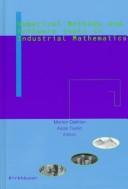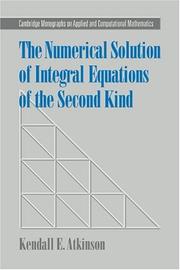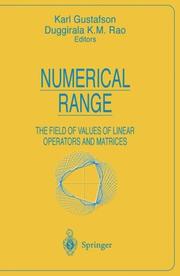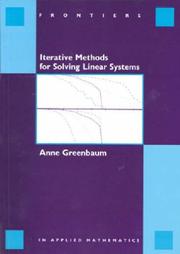| Listing 1 - 10 of 22 | << page >> |
Sort by
|

ISBN: 0070276846 0071153365 Year: 1997 Volume: *3 Publisher: New York St. Louis Auckland McGraw-Hill
Abstract | Keywords | Export | Availability | Bookmark
 Loading...
Loading...Choose an application
- Reference Manager
- EndNote
- RefWorks (Direct export to RefWorks)
Numerical analysis --- Computer science --- 519.6 --- 681.3 *G10 --- Computational mathematics. Numerical analysis. Computer programming --- Computerwetenschap--?*G10 --- Science --- Data processing. --- 519.6 Computational mathematics. Numerical analysis. Computer programming --- Electronic data processing --- Data processing
Book

ISBN: 2870372493 9782870372494 Year: 1997 Volume: 2 Publisher: Namur : Presses universitaires de Namur,
Abstract | Keywords | Export | Availability | Bookmark
 Loading...
Loading...Choose an application
- Reference Manager
- EndNote
- RefWorks (Direct export to RefWorks)
Quantum chemistry --- fysicochemie --- Chimie physique --- Fysische chemie --- Chemistry --- Data processing --- Mathematics --- 519.6:54 --- #WSCH:AAS2 --- Computational mathematics. Numerical analysis. Computer programming-:-Chemistry. Mineralogical sciences --- 519.6:54 Computational mathematics. Numerical analysis. Computer programming-:-Chemistry. Mineralogical sciences --- Data processing. --- Computer simulation --- Exercises --- Computational chemistry. --- Electron correlation --- Hartree-fock method --- Polymer chains --- Relativity --- Temperature

ISBN: 0133677230 9780133677232 Year: 1997 Publisher: Upper Saddle River (N.J.): Prentice Hall,
Abstract | Keywords | Export | Availability | Bookmark
 Loading...
Loading...Choose an application
- Reference Manager
- EndNote
- RefWorks (Direct export to RefWorks)
Physics --- Data processing. --- 53 --- -#WSCH:AAS2 --- 519.6 --- 681.3*J2 --- Natural philosophy --- Philosophy, Natural --- Physical sciences --- Dynamics --- Data processing --- Computational mathematics. Numerical analysis. Computer programming --- Physical sciences and engineering (Computer applications) --- 681.3*J2 Physical sciences and engineering (Computer applications) --- 519.6 Computational mathematics. Numerical analysis. Computer programming --- 53 Physics --- #WSCH:AAS2 --- Physics - Data processing.

ISBN: 0817639160 3764339160 1461264138 0817681361 Year: 1997 Publisher: Boston (Mass.) : Birkhäuser,
Abstract | Keywords | Export | Availability | Bookmark
 Loading...
Loading...Choose an application
- Reference Manager
- EndNote
- RefWorks (Direct export to RefWorks)
Probably I ought to explain why one more book on numerical methods can be useful. Without any doubt, there are many quite good and excellent books on the subject. But I know definitely that I did not realize this when I was a student. In this book, my first desire was to present those lectures that I wished I would have heard when I was a student. Besides, in spite of the profusion of textbooks, introductory courses, and monographs on numerical methods, some of them are too elementary, some are too difficult, some are far too overwhelmedwith applications, and most of them are too lengthy for those who want to see the whole picture in a short time. I hope that the brevity of the course left me no chance to obscure the beauty and depth of mathematical ideas behind the theory and methods of numerical analysis. I am convincedthat such a book should be very conciseindeed. It should be thoroughly structured, giving information in short sections which, ideally, are a half-page in length. Equally important, the book should not give an impression that nothing is left to work on in this field. Any time it becomes possible to say something about modern development and recent results, I do try to find time and place for this.
Numerical analysis. --- Numerical analysis --- Analyse numérique --- #WWIS:didaktiek --- 519.6 --- 519.6 Computational mathematics. Numerical analysis. Computer programming --- Computational mathematics. Numerical analysis. Computer programming --- Mathematical analysis --- Analyse numérique --- Analyse numérique. --- Computer mathematics. --- Numerical Analysis. --- Computational Mathematics and Numerical Analysis. --- Computer mathematics --- Electronic data processing --- Mathematics --- Analyse numérique.

ISBN: 081763973X Year: 1997 Publisher: Boston Birkhäuser
Abstract | Keywords | Export | Availability | Bookmark
 Loading...
Loading...Choose an application
- Reference Manager
- EndNote
- RefWorks (Direct export to RefWorks)
Engineering mathematics --- Industrial engineering --- 519.6 --- 519.6 Computational mathematics. Numerical analysis. Computer programming --- Computational mathematics. Numerical analysis. Computer programming --- Management engineering --- Simplification in industry --- Engineering --- Value analysis (Cost control) --- Engineering analysis --- Mathematical analysis --- Industrial applications --- Mathematics&delete& --- Computer programs --- Mathematics --- Programming

ISBN: 0262720272 9780262288408 9780262720274 0262288400 0585037965 Year: 1997 Publisher: Cambridge : The Mit Press,
Abstract | Keywords | Export | Availability | Bookmark
 Loading...
Loading...Choose an application
- Reference Manager
- EndNote
- RefWorks (Direct export to RefWorks)
Many science and engineering applications require the user to find solutions to systems of nonlinear constraints or to optimize a nonlinear function subject to nonlinear constraints. The field of global optimization is the study of methods to find all solutions to systems of nonlinear constraints and all global optima to optimization problems. Numerica is modeling language for global optimization that makes it possible to state nonlinear problems in a form close to the statements traditionally found in textbooks and scientific papers. The constraint-solving algorithm of Numerica is based on a combination of traditional numerical methods such as interval and local methods, and constraint satisfaction techniques.This comprehensive presentation of Numerica describes its design, functions, and implementation. It also discusses how to use Numerica effectively to solve practical problems and reports a number of experimental results.A commercial implementation of Numerica is available from ILOG under the name ILOG Numerica.
Mathematical optimization --- Nonlinear programming --- 519.6 --- 681.3*G16 --- 681.3*G4 --- Programming (Mathematics) --- Optimization (Mathematics) --- Optimization techniques --- Optimization theory --- Systems optimization --- Mathematical analysis --- Maxima and minima --- Operations research --- Simulation methods --- System analysis --- Computational mathematics. Numerical analysis. Computer programming --- Optimization: constrained optimization; gradient methods; integer programming; least squares methods; linear programming; nonlinear programming (Numericalanalysis) --- Mathematical software: algorithm analysis; certification and testing; efficiency; portability; reliability and robustness; verification --- 681.3*G4 Mathematical software: algorithm analysis; certification and testing; efficiency; portability; reliability and robustness; verification --- 681.3*G16 Optimization: constrained optimization; gradient methods; integer programming; least squares methods; linear programming; nonlinear programming (Numericalanalysis) --- 519.6 Computational mathematics. Numerical analysis. Computer programming --- 519.6 <066> --- 519.6 <066> Computational mathematics. Numerical analysis. Computer programming--?<066> --- Computational mathematics. Numerical analysis. Computer programming--?<066> --- Numerica. --- Mathematical optimization. --- Nonlinear programming. --- COMPUTER SCIENCE/Programming Languages

ISBN: 0521583918 Year: 1997 Volume: 4 Publisher: Cambridge ; New York, NY : Cambridge University Press,
Abstract | Keywords | Export | Availability | Bookmark
 Loading...
Loading...Choose an application
- Reference Manager
- EndNote
- RefWorks (Direct export to RefWorks)
Integral equations --- Equations intégrales --- Numerical solutions --- Solutions numériques --- -#KVIV:BB --- 519.6 --- 681.3*G19 --- Equations, Integral --- Functional equations --- Functional analysis --- Computational mathematics. Numerical analysis. Computer programming --- Integral equations: Fredholm equations; integro-differential equations; Volterra equations (Numerical analysis) --- Numerical solutions. --- 681.3*G19 Integral equations: Fredholm equations; integro-differential equations; Volterra equations (Numerical analysis) --- 519.6 Computational mathematics. Numerical analysis. Computer programming --- Equations intégrales --- Solutions numériques --- #KVIV:BB --- Numerical analysis --- Analyse numérique. --- Analyse numérique --- Numerical analysis. --- Equations integrales --- Methodes numeriques
Book
ISBN: 185312463X Year: 1997 Publisher: Southampton Computational mechanics publ.
Abstract | Keywords | Export | Availability | Bookmark
 Loading...
Loading...Choose an application
- Reference Manager
- EndNote
- RefWorks (Direct export to RefWorks)
532.5 --- 551.466 --- 536.7 --- 624.04 --- 519.6 --- Liquid motion. Hydrodynamics --- Sea waves and tides --- Thermodynamics. Energetics --- Structural design. Graphical and analytical statics for investigation and calculation of structures --- Computational mathematics. Numerical analysis. Computer programming --- 519.6 Computational mathematics. Numerical analysis. Computer programming --- 624.04 Structural design. Graphical and analytical statics for investigation and calculation of structures --- 536.7 Thermodynamics. Energetics --- 551.466 Sea waves and tides --- 532.5 Liquid motion. Hydrodynamics

ISBN: 038794835X 1461384982 9780387948355 Year: 1997 Publisher: New York (N.Y.): Springer
Abstract | Keywords | Export | Availability | Bookmark
 Loading...
Loading...Choose an application
- Reference Manager
- EndNote
- RefWorks (Direct export to RefWorks)
The theories of quadratic forms and their applications appear in many parts of mathematics and the sciences. All students of mathematics have the opportunity to encounter such concepts and applications in their first course in linear algebra. This subject and its extensions to infinite dimen sions comprise the theory of the numerical range W(T). There are two competing names for W(T), namely, the numerical range of T and the field of values for T. The former has been favored historically by the func tional analysis community, the latter by the matrix analysis community. It is a toss-up to decide which is preferable, and we have finally chosen the former because it is our habit, it is a more efficient expression, and because in recent conferences dedicated to W(T), even the linear algebra commu nity has adopted it. Also, one universally refers to the numerical radius, and not to the field of values radius. Originally, Toeplitz and Hausdorff called it the Wertvorrat of a bilinear form, so other good names would be value field or form values. The Russian community has referred to it as the Hausdorff domain. Murnaghan in his early paper first called it the region of the complex plane covered by those values for an n x n matrix T, then the range of values of a Hermitian matrix, then the field of values when he analyzed what he called the sought-for region.
Numerical range. --- 519.6 --- 681.3*G13 --- 681.3*G13 Numerical linear algebra: conditioning; determinants; Eigenvalues; error analysis; linear systems; matrix inversion; pseudoinverses; sparse and very largesystems --- Numerical linear algebra: conditioning; determinants; Eigenvalues; error analysis; linear systems; matrix inversion; pseudoinverses; sparse and very largesystems --- 519.6 Computational mathematics. Numerical analysis. Computer programming --- Computational mathematics. Numerical analysis. Computer programming --- Numerical range --- Field of values --- Range, Numerical --- Values, Field of --- Linear operators --- Mathematical analysis. --- Analysis (Mathematics). --- Analysis. --- 517.1 Mathematical analysis --- Mathematical analysis

ISBN: 089871396X 9780898713961 Year: 1997 Volume: 17 Publisher: Philadelphia, PA : Society for Industrial and Applied Mathematics,
Abstract | Keywords | Export | Availability | Bookmark
 Loading...
Loading...Choose an application
- Reference Manager
- EndNote
- RefWorks (Direct export to RefWorks)
Iterative methods (Mathematics) --- Equations, Simultaneous --- Numerical solutions --- Simultaneous equations --- Numerical linear algebra: conditioning; determinants; Eigenvalues; error analysis; linear systems; matrix inversion; pseudoinverses; sparse and very largesystems --- 681.3*G13 Numerical linear algebra: conditioning; determinants; Eigenvalues; error analysis; linear systems; matrix inversion; pseudoinverses; sparse and very largesystems --- 519.6 --- 681.3*G13 --- 519.6 Computational mathematics. Numerical analysis. Computer programming --- Computational mathematics. Numerical analysis. Computer programming --- Iteration (Mathematics) --- Numerical analysis --- Iterative methods (Mathematics). --- Numerical solutions. --- Itération (Mathématiques) --- Equations, Simultaneous - Numerical solutions
| Listing 1 - 10 of 22 | << page >> |
Sort by
|

 Search
Search Feedback
Feedback About
About Help
Help News
News